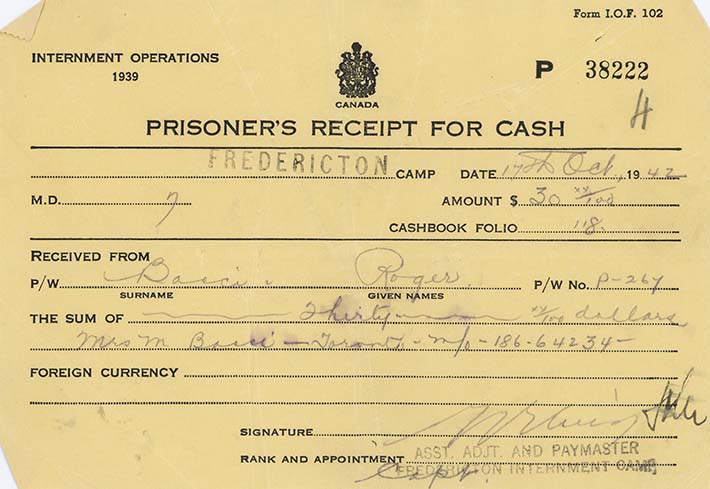Newest
internment, black and white, internee, photograph, document, internment & release, internment operations, petawawa internment camp, letter, internment camp, internees, mail, petawawa, toronto, portrait, camp life, correspondence, ruggero bacci, outdoors, italy,
Popular
black and white, camp, camp life, correspondence, document, family, family life, female, fredericton internment camp, internee, internees, internment, internment & release, internment camp, internment operations, italian canadian, italian canadians, italy, letter, libero sauro,
See all tagsTags
ruggero bacci, receipt, internment operations, internment & release, internment, fredericton internment camp, document, camp ripples, camp fredericton, camp #70, camp life
Add each tag separately.
RELATED
Collection objects
Internees
Prisoner's Receipt for Cash, Fredericton Internment Camp, October 17, 1942
Prisoner's Receipt for Cash, Fredericton Internment Camp, October 17, 1942. The receipt is for $30.00. It is unclear if this receipt is for money Ruggero Bacci received from his wife or for money he sent to his wife.
Internees who were under sixty years old did manual labour or vocational work. Others worked where they were needed. Internees were paid by the Canadian government 25 cents for a day’s work. Internees were not required by the authorities to work every day. In addition, internees could earn money informally by doing camp chores for others, like laundry. Those who were handy, also made things, like wood carvings, and sold them to other internees. Internees could also receive money from their families which would be credited to their camp accounts.
This system is described by Mario Duliani in his book The City Without Women. Duliani notes that money (paper and coins) was not permitted in camp. Instead, he describes a system where each internee had an account opened through the "Official Accountant". Against this account, the internee would be issued cardboard notes/chits valued at 5, 10, 25 cents and one dollar. This money could be used to purchase items from the camp canteen such as toothpaste and cigarettes.
Some letters suggest that internees could also send money earned in camp to their families.
For another receipt, see LICEA2012-0002-13.
Accession#
LICEA2012.0002.0068
Maker
Date
October 17, 1942
Classification
Inscriptions
Verso:
Credit Line
Acquisition Method
Loan
Have something to share?
Add a comment, a picture or share a video. Share with us













































































